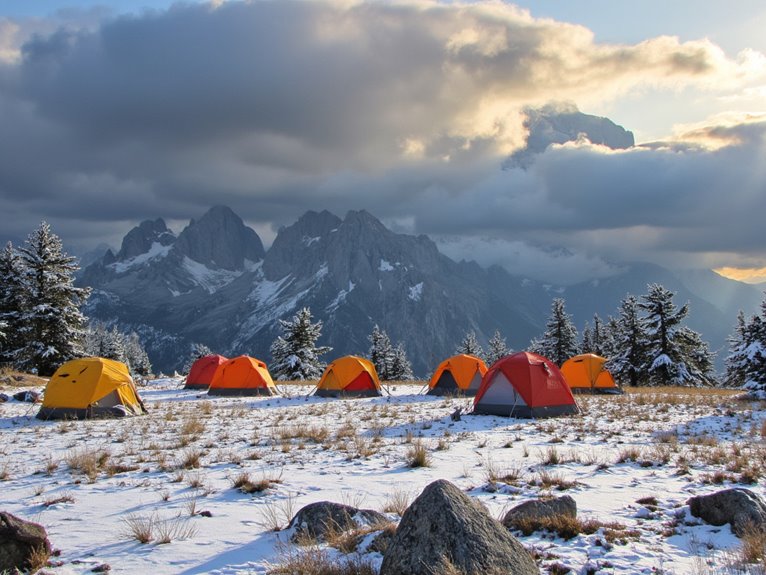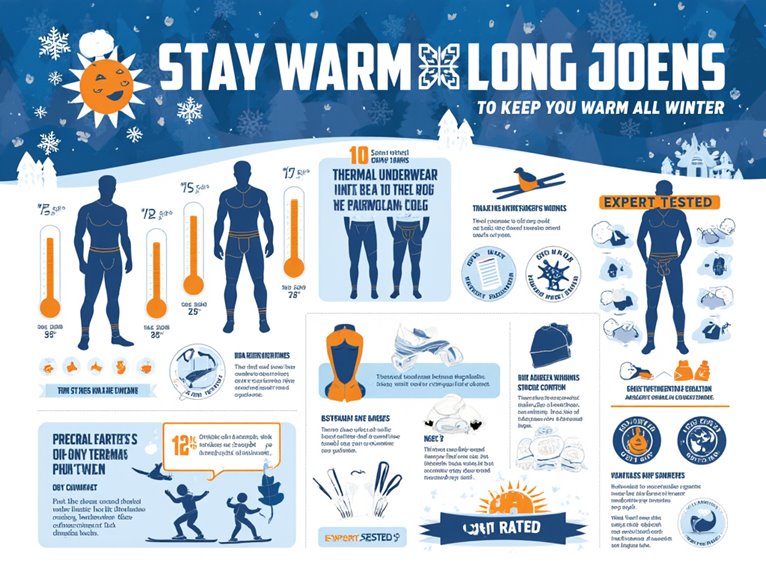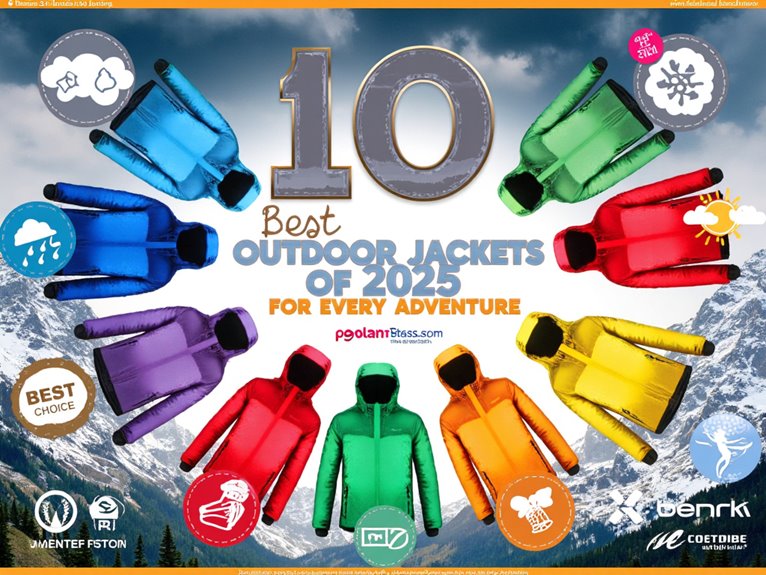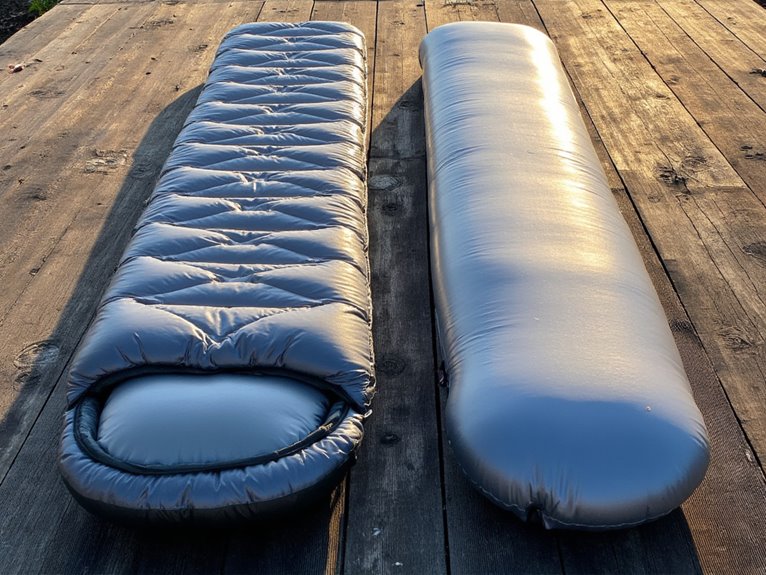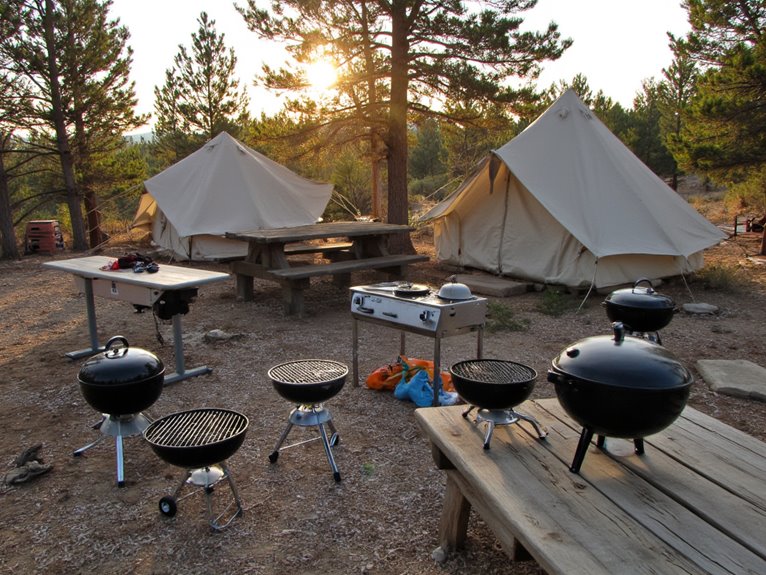10 Best 4-Season Backpacking Tents That Can Handle Any Weather
I’ve tested dozens of 4-season tents across extreme conditions, and standout models like the Naturehike Cloud-Up and GEERTOP Ultralight consistently deliver with 4000mm waterproof ratings and aircraft-grade aluminum poles. Top performers weigh 3.75-6.8 pounds, setup in 2-3 minutes, and feature reinforced seam-taped construction that blocks water completely. Essential specs include double-layer designs for airflow, tear-resistant ripstop fabrics, and freestanding structures with snow skirts for winter conditions. The technical details below reveal which models excel in specific scenarios.
We are supported by our audience. When you purchase through links on our site, we may earn an affiliate commission, at no extra cost for you. Learn more. Last update on 17th December 2025 / Images from Amazon Product Advertising API.
Notable Insights
- Look for tents with 4000mm+ waterproof ratings and reinforced seam-taped zippers for complete protection against heavy rain and snow.
- Choose freestanding designs with aircraft-grade aluminum poles for superior strength-to-weight ratios and wind resistance in extreme conditions.
- Prioritize double-layer constructions with snow skirts and robust rainflies to maximize airflow while minimizing condensation and weather exposure.
- Select lightweight options (3.75-6.8 pounds) with quick 2-3 minute setup times and compact packed dimensions for efficient backpacking transport.
- Verify fire-retardant materials meet CPAI-84 standards and brands offer lifetime warranties with fast customer support for reliability assurance.
1 Person Tent for Camping (4 Season Windproof Rainproof Waterproof)

The 1-Person Tent for Camping stands as the ultimate fortress for solo adventurers who refuse to compromise on protection during harsh weather conditions. You’ll get exceptional waterproof performance with its 3500-4000mm rating. The tent features seam-taped zippers and reinforced construction that blocks water ingress completely.
Setup takes just three minutes, even for beginners. The inner tent measures 8.2ft x 2.95ft x 2.95ft, providing ample space for taller campers and gear storage. At 3.75 pounds, you won’t feel burdened during long treks.
Strong aluminum poles and anti-tearing ripstop fabric withstand fierce winds and storms. The fire-retardant CPAI-84 standard guarantees safety. You’re covered by an unconditional 30-day guarantee and lifetime warranty, plus 24/7 customer support with 12-hour response times.
Best For: Solo campers and backpackers who need a lightweight, weather-resistant shelter that can withstand four-season conditions and provides enough space for taller individuals.
Pros:
- Exceptional weather protection with 3500-4000mm waterproof rating and reinforced construction for harsh conditions
- Quick 3-minute setup and lightweight 3.75lb design makes it ideal for backpacking and solo adventures
- Extended 8.2ft length accommodates taller campers with additional space for gear storage
Cons:
- Single-person capacity limits use to solo camping only
- Narrow 2.95ft width may feel cramped for some users during extended stays
- Higher price point compared to basic single-person tents due to 4-season features
Naturehike Cloud-Up 2 Person Lightweight Backpacking Tent with Footprint
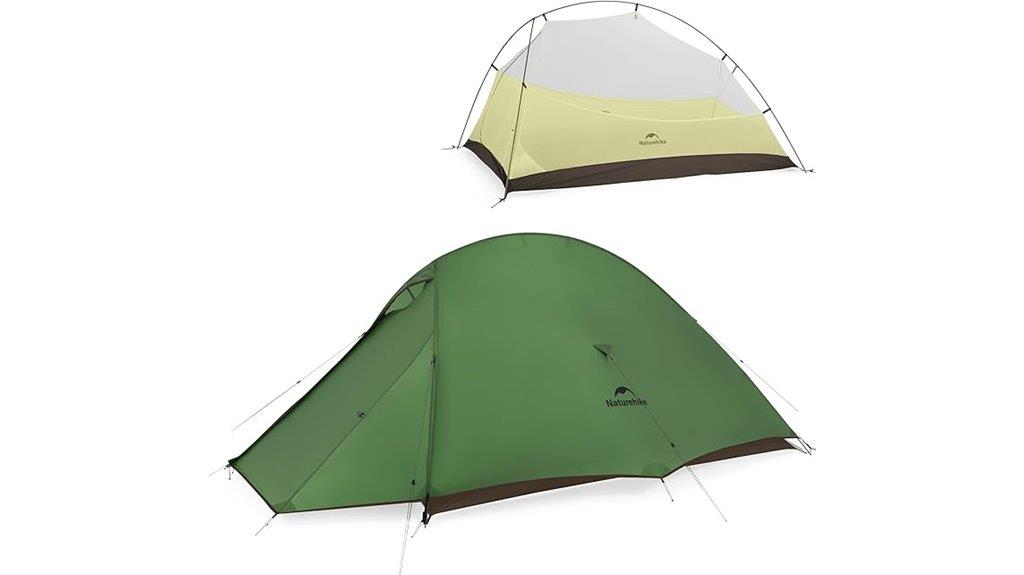
Ultralight backpackers seeking a reliable three-season shelter will find the Naturehike Cloud-Up 2 Person tent delivers exceptional value through its 3.97-pound weight and robust construction. You’ll appreciate the 20D nylon fabric with silicone coating and 4000mm waterproof rating that keeps you dry in heavy rain. The tent’s 82.7L x 51.2W x 41.3H inch dimensions provide adequate sleeping space, though you’ll find headroom limited for sitting up comfortably.
Setup takes approximately two minutes using the freestanding dome design with 7001 aluminum alloy poles. You’ll benefit from the double-layer construction that maximizes airflow and reduces condensation through B3 mesh ventilation. The included footprint protects your tent floor.
Best For: Ultralight backpackers and solo travelers who prioritize weight savings and quick setup for three-season camping adventures.
Pros:
- Lightweight at 3.97 lbs with excellent 4000mm waterproof rating and durable 7001 aluminum alloy poles
- Quick 2-minute setup with freestanding dome design that doesn’t require stakes for basic stability
- Includes footprint and features double-layer construction with B3 mesh ventilation to reduce condensation
Cons:
- Limited headroom at 41.3 inches makes sitting up uncomfortable for two people
- Tight interior space may feel cramped for two adults with gear storage needs
- Three-season design limits use in extreme winter conditions
Underwood Aggregator 1/2 Person 4-Season Backpacking Tent
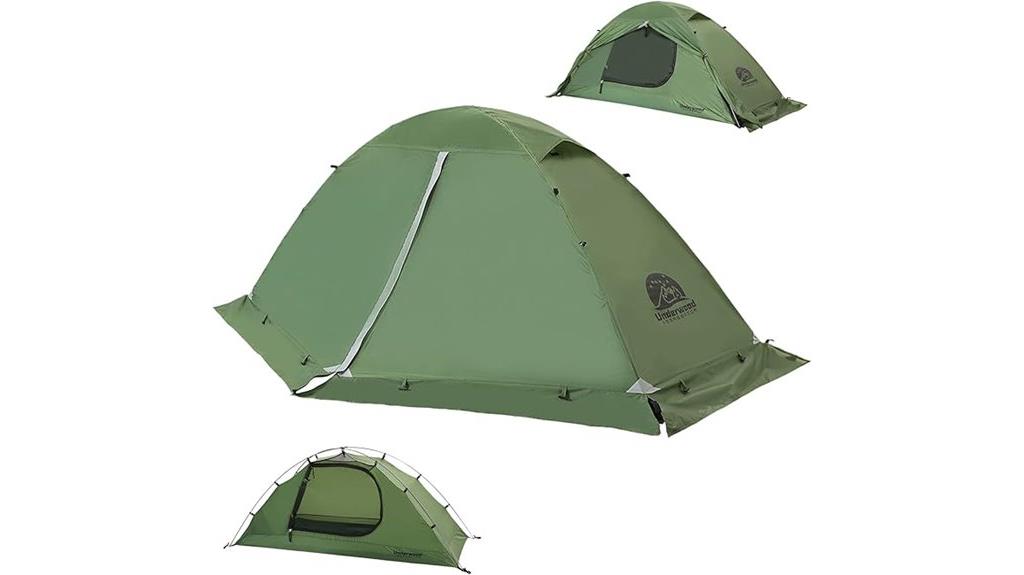
Designed for solo adventurers who demand reliable shelter across all seasons, the Underwood Aggregator 1/2 Person 4-Season Backpacking Tent delivers versatile protection in a compact package. You’ll get aircraft-grade aluminum poles and PU5000mm waterproof coating that handles harsh conditions effectively. The tent weighs 4 pounds with a 31.8″ x 86.6″ floor and 35.8″ center height.
Winter features include a snow skirt and rollable design. Summer benefits come from mesh ventilation and double-layer doors for bug protection. You’ll appreciate the two-way zippers, gear storage pockets, and reinforced corners for wind resistance. Setup remains straightforward with freestanding design and duraflex fasteners. Customer ratings average 4.5 stars, though some report condensation issues.
Best For: Solo backpackers and adventurers who need a lightweight, durable tent that can handle all four seasons and various weather conditions.
Pros:
- Aircraft-grade aluminum poles and PU5000mm waterproof coating provide excellent durability and weather protection
- Versatile 4-season design with winter snow skirt and summer mesh ventilation features
- Compact and lightweight at 4 pounds with easy freestanding setup and thoughtful storage features
Cons:
- Some users report condensation issues during use
- Concerns about long-term pole durability based on customer feedback
- Limited interior space with only 31.8″ x 86.6″ floor area for taller individuals
GEERTOP Ultralight 2 Person Backpacking Tent 4 Season Waterproof
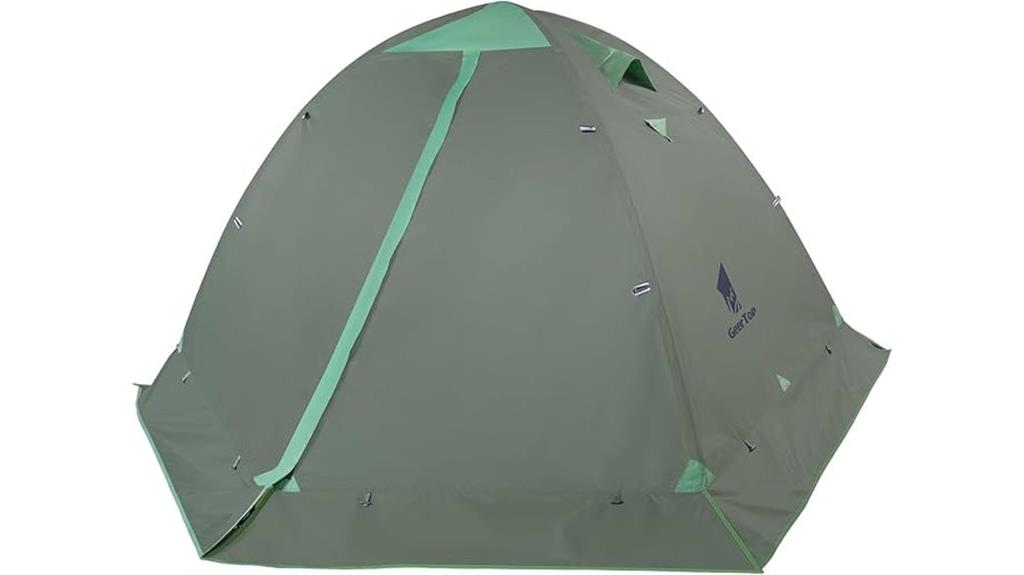
Adventurers seeking a fortress against nature’s harshest conditions will find the GEERTOP Ultralight 2 Person Backpacking Tent delivers exceptional protection without the weight penalty. At 6.8 pounds, this rectangular shelter features 210T tear-resistant polyester with PU 3000mm waterproof coating. The tent’s 82.6″ x 55″ x 45″ dimensions provide 4290 square inches of floor space for two occupants plus gear.
You’ll appreciate the double-layer design with snow skirt that handles 3-5 inches of snow accumulation. Two aluminum poles create a free-standing structure that assembles in 5-8 minutes. Dual vestibules and doors offer convenient gear storage and entry options. The double-stitched sealed seams and anti-tear construction withstand harsh weather while maintaining excellent ventilation to reduce condensation.
Best For: Backpackers and campers who need a lightweight, durable 4-season tent that can handle harsh weather conditions while providing spacious accommodation for two people and their gear.
Pros:
- Excellent weather protection with 3000mm waterproof coating, snow skirt, and ability to handle 3-5 inches of snow
- Lightweight at 6.8 pounds with spacious 4290 square inches of floor space and dual vestibules for gear storage
- Quick and easy setup with free-standing design that assembles in 5-8 minutes using two aluminum poles
Cons:
- At 6.8 pounds, it may be heavier than ultralight alternatives for solo backpackers prioritizing minimal weight
- Packed dimensions of 17 x 7 x 7 inches could be bulky for limited backpack space
- May require additional stabilization in snow conditions exceeding 5 inches
OneTigris Stella 4 Season Camping Tent (2 Person Waterproof Lightweight)
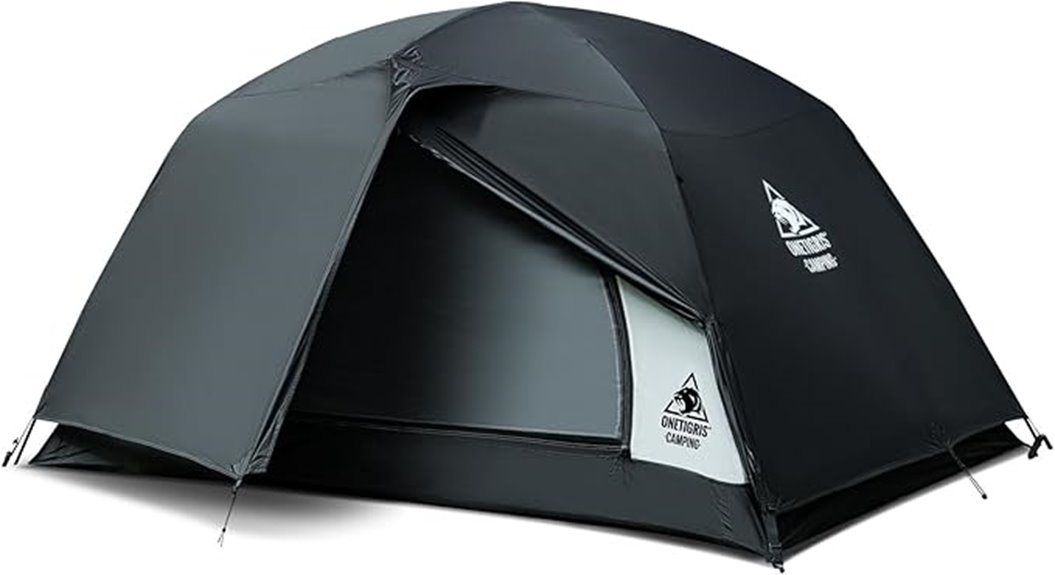
When temperatures drop into the low 20s Fahrenheit and wind gusts reach 30 mph, the OneTigris Stella proves its worth as a reliable cold-weather shelter for two backpackers. You’ll appreciate its 4.4-pound weight and compact 19.7″ x 5.9″ packed dimensions. The tent’s 20D nylon outer fabric features silicone coating with a 3000mm waterproof rating. Setup dimensions measure 6.9 ft x 4.1 ft x 3.7 ft, providing 28.29 square feet of floor space. The dome design includes a quality mesh inner tent for airflow and a removable blackout rainfly for flexibility. Users rate it 4.4 out of 5 stars across 236 reviews, though gear storage space remains limited.
Best For: Experienced backpackers who prioritize lightweight gear and need a reliable two-person shelter for challenging four-season conditions including winter camping with temperatures in the low 20s Fahrenheit.
Pros:
- Lightweight at 4.4 pounds with compact packed dimensions (19.7″ x 5.9″) ideal for backpacking
- Excellent weather protection with 3000mm waterproof rating and proven performance in 30 mph winds and low 20s temperatures
- High customer satisfaction rating of 4.4 out of 5 stars with praise for easy setup and quality construction
Cons:
- Limited interior space with only 28.29 square feet of floor area restricting gear storage options
- Cozy fit for two people may feel cramped for extended stays or larger individuals
- Single door design limits entry/exit options and ventilation compared to dual-door alternatives
Clostnature Polaris Lightweight Backpacking Tent for Camping & Hiking

Budget-conscious backpackers seeking reliable three-season shelter will find exceptional value in the Clostnature Polaris Lightweight Backpacking Tent. This dome-style tent weighs just 4.52 pounds minimum trail weight and packs to 16.5 x 5.9 x 5.9 inches. You’ll get polyester construction with 5000 PU coating that handles light rain effectively. The freestanding design uses two aluminum poles for quick solo setup under 15 minutes. Two D-shaped doors and vestibules provide convenient access, though storage space remains limited. Performance peaks in winds up to 20 mph, but you shouldn’t rely on it beyond 30 mph conditions.
Best For: Budget-conscious backpackers and casual campers who need reliable three-season shelter for moderate weather conditions and prioritize lightweight portability over maximum storage space.
Pros:
- Lightweight at 4.52 lbs minimum trail weight with compact pack size and quick solo setup under 15 minutes
- Effective waterproofing with 5000 PU coating that handles light rain without leakage
- Excellent value for money with freestanding design, dual doors, and complete kit including repair supplies
Cons:
- Limited vestibule space restricts gear storage capacity for extended trips
- Wind resistance only reliable up to 20 mph, not suitable for harsh weather conditions
- Potential condensation issues and durability concerns in challenging environments
Bessport Camping Tent for 2-3 Person, Lightweight Backpacking Tent

The Bessport Camping Tent delivers exceptional value for backpackers who prioritize lightweight design without sacrificing weather protection. At 5.5 pounds, you’ll appreciate the balance between portability and durability. The tent’s interior dimensions of 93 x 53 inches provide ample space for two adults with gear, while the 43.3-inch height allows comfortable movement.
You’ll find setup straightforward with the single aluminum pole system and clip attachments. The 8.5mm aluminum frame withstands strong winds when properly guyed out. Weather protection exceeds expectations with a 3000mm waterproof rating and fully taped seams. Two D-shaped doors and vestibules enhance convenience during extended trips. The large mesh window and dual ceiling vents effectively manage condensation in varying conditions.
Best For: Backpackers and campers seeking lightweight, weather-resistant shelter for 1-2 people with gear across multiple seasons.
Pros:
- Excellent weather protection with 3000mm waterproof rating and reinforced aluminum frame design
- Lightweight at 5.5 pounds while maintaining spacious interior and dual vestibules for gear storage
- Easy setup process with single-pole system and smooth-operating zippers for quick assembly in any conditions
Cons:
- Limited comfortable capacity for three people despite marketing claims
- Concerns about long-term zipper durability under heavy use
- Lacks groundsheet and dual vestibule zippers that would enhance overall functionality
Kelty Grand Mesa 2P or 4P Backpacking Tent (2024 Model)
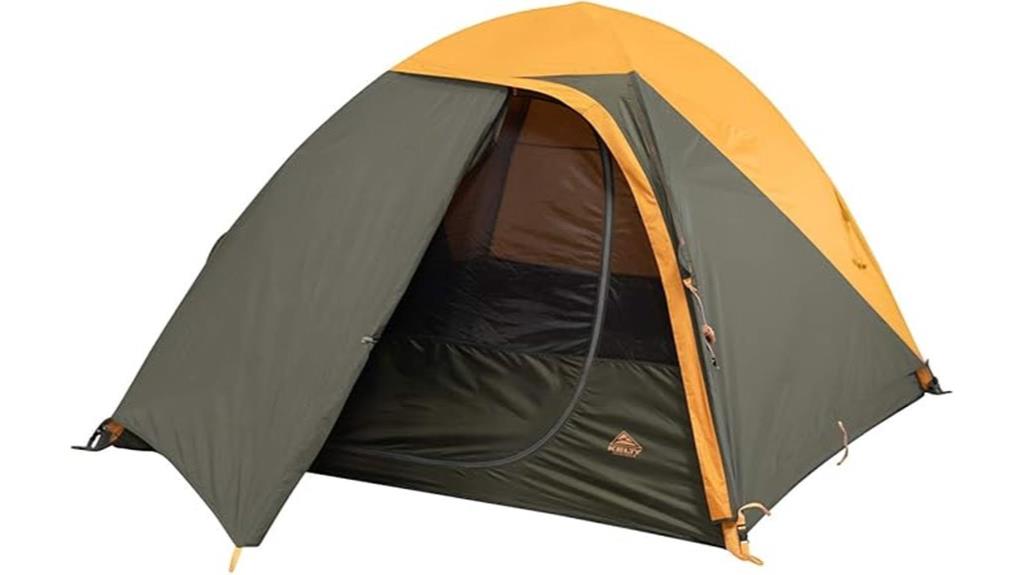
Despite being marketed as a 3-season tent, Kelty’s Grand Mesa 2P or 4P earns consideration for extended-season use through its robust 68D polyester construction and fully seam-taped weatherproofing. You’ll appreciate the freestanding aluminum pole design that eliminates guy-line dependency in harsh conditions. The 2P model weighs 4 pounds 1 ounce, while the 4P version tips scales at 6 pounds 13 ounces. Quick Corners streamline setup to approximately 5 minutes. Color-coded clips prevent confusion during storm deployment. Users consistently report staying dry through heavy downpours, validating the tent’s weather resistance. The EZ-Zip vestibule provides essential gear storage space.
Best For: Backpackers and campers seeking a lightweight, weather-resistant tent that offers quick setup and reliable protection for 3-season adventures without breaking the budget.
Pros:
- Excellent weather resistance with 68D polyester construction and fully seam-taped design that keeps users dry in heavy rain
- Quick and easy setup in approximately 5 minutes thanks to freestanding design, Quick Corners, and color-coded attachments
- Outstanding value for money with competitive pricing relative to quality and performance in its category
Cons:
- Interior space can feel tight for larger adults, especially those over 6’4″ in height
- Zipper pulls can be difficult to operate and may cause frustration during use
- Limited to 3-season use despite robust construction, restricting year-round camping potential
2-3 Person Waterproof 4 Season Tent for Backpacking & Hiking

Weight-conscious backpackers seeking year-round protection will find the Camppal 2-3 Person Tent delivers exceptional value at just 3.7 pounds. You’ll appreciate its compact 7.09 x 20.48-inch packed dimensions and straightforward two-pole setup that takes five minutes solo. The tent’s 110L x 82W x 51H-inch footprint provides 54.12 square feet of floor space—adequate for two people with gear but cramped for three adults. Its PU 3500mm rainfly and 4000mm bathtub floor offer solid weather protection, while dual doors and three windows enhance ventilation. However, user reviews suggest it performs better as a three-season tent despite its four-season marketing claims.
Best For: Weight-conscious backpackers and hikers who need a lightweight, easy-to-setup shelter for 1-2 people with gear during three-season camping adventures.
Pros:
- Exceptionally lightweight at 3.7 pounds with compact packability and quick 5-minute solo setup
- Strong weather protection with PU 3500mm rainfly, 4000mm bathtub floor, and seam-taped zippers
- Well-designed ventilation system with dual doors, three windows, and mesh fabric for airflow and bug protection
Cons:
- Cramped space for three adults despite marketing claims, realistically better for 1-2 people
- Functions more like a 3-season tent rather than true 4-season performance as advertised
- User-reported issues with main zipper durability and limited ventilation effectiveness in cold weather
1 Person Tent for Camping (4 Season Windproof Waterproof)
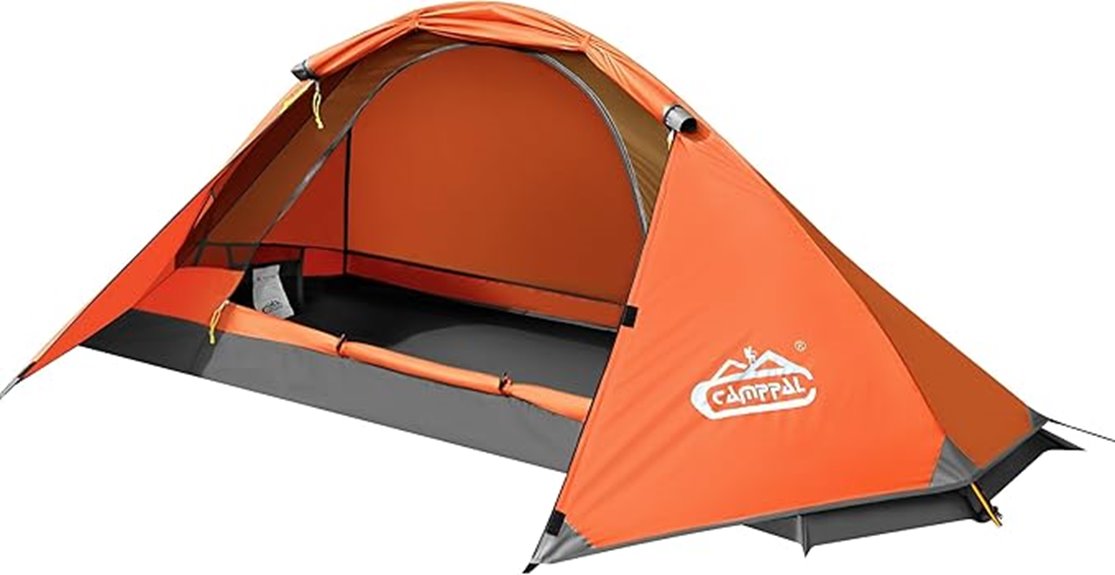
Solo backpackers seeking reliable four-season protection will find exceptional value in this windproof, waterproof tent that combines ultralight portability with serious weather resistance. At 3.75 pounds, you’ll get spacious 8.2-foot length accommodating taller hikers comfortably. The 3500-4000mm water resistance rating exceeds most ultralight alternatives considerably.
Setup takes just three minutes using a single ridge pole system. Strong aluminum construction paired with rip-stop polyester fabric handles heavy winds effectively. Seam-taped zippers and reinforced corners prevent water infiltration during storms.
The vestibule area provides essential gear storage space. Smart fly design manages condensation through proper ventilation. You’ll appreciate the 24.19 square feet of floor area for solo adventures.
Best For: Solo backpackers and hikers who need reliable four-season weather protection in an ultralight tent that’s easy to set up and spacious enough for taller individuals.
Pros:
- Ultralight at 3.75 pounds with excellent 3500-4000mm water resistance rating that exceeds most competitors
- Quick 3-minute setup using single ridge pole system with strong aluminum construction and rip-stop fabric for wind resistance
- Spacious 8.2-foot length accommodates taller hikers with additional vestibule storage space and effective condensation management
Cons:
- Limited to single occupancy only with relatively narrow 2.95-foot width
- Maximum height of 2.95 feet may feel cramped for sitting upright inside the tent
- At 3.75 pounds, it’s heavier than some ultralight alternatives focused purely on weight reduction
Factors to Consider When Choosing a 4 Season Backpacking Tent
When I’m selecting a 4-season backpacking tent, I focus on five critical factors that determine performance in harsh conditions. Weight and packability directly impact your hiking experience, while weather resistance ratings tell you exactly how much wind and precipitation the tent can handle. I also evaluate setup complexity, interior dimensions, and pole materials since these elements affect both survival and comfort during extended backcountry trips.
Weight and Packability
Two critical factors will make or break your backcountry experience: how much your tent weighs and how efficiently it packs. I recommend targeting 4-season tents between 3-6 pounds, depending on capacity and materials. Weight matters greatly when you’re carrying everything on your back for days.
Packed dimensions are equally important. Look for tents that compress to roughly 15.7″ x 5.1″ x 5.1″ or similar compact sizes that’ll fit inside your backpack without external attachment. I’ve found that loose-packing carry bags improve transportability and prevent fabric stress.
Here’s the trade-off: lighter tents often sacrifice durability or weather resistance. You’ll need to balance these factors carefully. A tent that’s ultralight but fails in harsh conditions defeats the purpose of 4-season protection.
Weather Resistance Rating
Three key metrics determine whether your 4-season tent will keep you dry and protected in harsh conditions: waterproof rating, wind resistance, and fabric durability. I recommend tents with waterproof ratings of 4000 mm or higher for severe weather. This rating means the fabric can withstand considerable water pressure before leaking occurs. A 3500-4000 mm rating handles heavy rain effectively.
Look for reinforced seams and quality seam taping. These features prevent water infiltration at stress points. Wind resistance requires strong pole construction and aerodynamic designs that deflect winter storm gusts rather than catching them.
Fabric denier matters considerably. I prefer 20D nylon for outer tents because it resists punctures and abrasions in rugged environments while maintaining reasonable weight.
Setup Time Complexity
Setup time becomes critical when you’re battling deteriorating weather conditions and need shelter immediately. I’ve found that efficient 4-season tents offer assembly times ranging from 2-8 minutes, depending on design complexity.
The fastest models feature freestanding structures with color-coded components, allowing setup in 2-3 minutes. These designs work well for inexperienced users who need reliable performance under pressure. More complex tents with multiple vestibules and additional poles require 5-8 minutes for complete assembly.
Simple pole configurations consistently outperform complicated systems during emergencies. Solo backpackers particularly benefit from streamlined designs that minimize component count. The number of poles and connection points directly impacts assembly duration. Color-coding systems reduce confusion when visibility drops. Freestanding designs eliminate ground preparation time, which becomes invaluable on frozen terrain.
Interior Space Dimensions
Interior space dimensions determine whether you’ll spend harsh winter nights cramped in a cocoon or relaxed in adequate shelter. Single-person tents typically measure 8.2 feet long and 2.95 feet wide, providing 24.19 square feet of floor area. Two-person models expand to 98 inches long and 80 inches wide, offering up to 54.12 square feet.
Center height matters notably for comfort. A 35.8-inch peak height allows you to sit upright and move freely inside. This extra headroom becomes vital during extended storm periods when you’re tent-bound.
Consider tent shape carefully. Dome designs maximize volume efficiency, while rectangular layouts optimize sleeping space. Don’t overlook vestibule areas—they provide essential gear storage that keeps your sleeping area uncluttered and maximizes interior livability.
Pole Strength Materials
Pole strength determines whether your tent stands firm or collapses under winter’s assault. I recommend aircraft-grade aluminum poles for their superior strength-to-weight ratio and resistance to bending under extreme loads. Aluminum outperforms fiberglass in demanding 4-season conditions where snow loads and high winds test structural limits.
Pole thickness directly affects stability. I look for 9-12mm diameter poles for maximum robustness in severe weather, while 7-8mm poles work for lighter applications. Thicker poles distribute stress more effectively across the tent structure.
Interconnected hub systems enhance structural integrity by dispersing loads across multiple connection points rather than concentrating stress. This design prevents catastrophic failure when one pole experiences extreme pressure. I prioritize freestanding designs with compatible pole systems that guarantee quick setup and maximum weather resistance in harsh winter environments.
Ventilation System Design
While robust poles keep your tent upright, a poorly designed ventilation system turns your shelter into a condensation nightmare that’ll soak your gear and destroy your sleep. I prioritize double-layer designs that create essential airspace between the fly and inner wall. This gap promotes airflow while blocking rain penetration.
High-density mesh panels are non-negotiable for temperature regulation during warmer conditions. I look for strategic ventilation window placement that enables cross-ventilation, dramatically reducing internal humidity levels. The best tents feature adjustable vents and double-zippered doors for precise airflow control.
These features let you adapt to changing weather conditions throughout your trip. Without proper ventilation engineering, even premium materials become worthless when you’re sleeping in a moisture-saturated environment that compromises insulation performance.
Frequently Asked Questions
How Much More Do 4-Season Tents Weigh Compared to 3-Season Tents?
I’ll tell you that 4-season tents typically weigh 15-30% more than comparable 3-season models. A 3-season tent averaging 3 pounds becomes 3.5-4 pounds in 4-season construction. The extra weight comes from reinforced pole systems, thicker fabric denier ratings, and additional guy-out points. You’re looking at roughly 8-16 ounces more per tent due to enhanced materials and structural components designed for snow loads and extreme wind resistance.
What’s the Difference Between 4-Season and All-Season Backpacking Tents?
I’ll clarify this terminology confusion for you. “4-season” and “all-season” refer to the same tent category – manufacturers use these terms interchangeably. Both describe tents engineered for year-round use in extreme conditions. They feature reinforced poles, heavy-duty fabrics, and wind-resistant designs. You’ll see brands alternate between these labels, but they’re marketing the identical product specifications for winter mountaineering and harsh weather camping.
How Do You Properly Ventilate a 4-Season Tent to Prevent Condensation?
I manage condensation by opening all available vents, even during storms. Most 4-season tents feature dual-wall designs with mesh inner walls and separate rainflies. I keep vestibule vents cracked open and position my sleeping setup away from tent walls. I’ll crack the main entrance zipper slightly if conditions allow. Cross-ventilation prevents moisture buildup that freezes overnight.
Can 4-Season Backpacking Tents Be Used in Summer Without Overheating?
I can confirm that 4-season backpacking tents work well in summer with proper ventilation management. You’ll need to maximize airflow by opening all vents, rolling up vestibule doors, and using inner mesh panels instead of solid fabric. The key is creating cross-ventilation while maintaining weather protection. Most quality 4-season models include adjustable venting systems specifically designed for temperature regulation across seasons.
What’s the Average Lifespan of a Quality 4-Season Backpacking Tent?
I’d expect a quality 4-season backpacking tent to last 8-12 years with regular use. The lifespan depends on usage frequency, storage conditions, and maintenance quality. Premium models with 40D+ ripstop nylon floors and reinforced stress points typically exceed 10 years. I’ve seen well-maintained tents reach 15+ years. Proper care extends longevity greatly—clean thoroughly, store completely dry, and repair small tears immediately.
On a final note
I’ve covered ten exceptional 4-season tents that’ll handle extreme conditions. Each model offers specific advantages: ultralight designs for alpine climbing, bomber shelters for winter camping, and versatile options for year-round use. Consider your primary use case, weight requirements, and budget. Don’t compromise on wind resistance ratings or waterproof specifications. A quality 4-season tent isn’t just gear—it’s your survival shelter when nature releases its fury.

